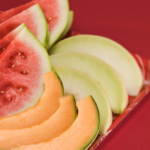Conquering the Hit and Miss Experience of Stone Fruit
Do you remember your last perfect peach, with juice dribbling down your chin one juicy, sweet bite after another? Those are the moments I long for each summer as peach season draws near. But when I stand in front of the peach display, niggling doubts creep in as I also remember biting into mealy, pasty peaches that make me question whether to buy peaches ever again. Know what I mean? How can we avoid those mealy disappointments and ensure a summer full of perfect peach moments? Let’s delve into the world of stone fruits and discover the best way to select, store and enjoy these summer delights.
Stone Fruit 101
Here’s some information about stone fruits that will not only impress your friends and earn you points at trivia night but will also help you become a savvy stone fruit shopper.
- Stone fruits are also known as “drupes” in the botanical world. Drupes are fruits that have a large, hard pit or stone inside. Common examples include peaches, plums, cherries, apricots, and nectarines. Surprise, avocados, lychees and olives are drupes too!
- Peak season for common drupes in North America is June to August. The season typically starts with cherries and is followed by peaches, nectarines and apricots in mid summer. Plums come in many varieties and are available throughout the season and even into early fall.
- Peaches, plums, apricots and nectarines continue to ripen a little bit after picking if stored at room temperature. But those that are too hard or too green will not develop their full flavour.
- Cherries do NOT continue to ripen once off the tree. What you buy is what you get.
- Nectarines are a natural variation of peaches; they are essentially a fuzz-less peach. They are typically slightly smaller, firmer and tangier than peaches and can be used in any peach recipe.
- Stone fruits are sensitive to temperature fluctuations and bruise easily with rough handling.
- Different varieties are more prone to mealiness than others with late season peaches and nectarines being more susceptible.
- Stone fruits are sensitive to temperature fluctuations. So, if, for example, they’re stored or transported too cool then displayed at warm temperatures and then cooled again at home they can stop ripening and turn mealy.
Selecting Stone Fruits
Here’s what these drupe facts mean to us when buying stone fruits:
- Buy stone fruit at peak season from grocers who handle produce with care.
- Buy cherries when they are ripe and plums, peaches, nectarines and apricots just slightly underripe (not overly green or hard).
- Look for vibrant colour, a slight give at the stem end, and a sweet aroma. Avoid bruised or overly soft fruit.
- Choose what you’ll use, buying only what you can enjoy within 5-7 days.
Storing Stone Fruits
- Place under-ripe, stone fruits in a single layer on your counter at room temperature. To speed up ripening, put them in a brown paper bag with a banana or apple. Watch carefully as they will ripen quickly.
- Once ripe, refrigerate to slow down further ripening.
- In the fridge, ensure proper air circulation and avoid build up of moisture by storing in the crisper drawer unwashed and uncovered. Use an open, ventilated container or bag.
Freezing & Preserving Stone Fruits
Stone fruits are excellent candidates for freezing and preserving.
To freeze, wash, remove the pit, slice and flash freeze in a single layer on a tray before sealing in an airtight bag or container.
Follow these tips to dehydrate or water bath can stone fruit.
Extra Bites – More Ways to Enjoy Stone Fruit
Here are some creative ways enjoy summer stone fruit. These ideas are great even if you do get bruised, over-ripe or mealy fruit.
- Harvest Crumble: A summer favourite, perfect for any stone fruit.
- Saucy Compote: Replace strawberries in this recipe with diced stone fruit and use it to top pancakes, waffles, ice cream, yogurt, etc.
- Refrigerator Jam: Follow Bob Blumer’s recipe for a delicious, no-canning required jam.
- Fruit Tart: Replace the apples in this quick and easy tart with firm stone fruit slices.
- Smoothies: Add soft, bruised or mealy stone fruit to your smoothies.
- Sweet & Savoury Salads: Stone fruit slices, even halved cherries add a beautiful touch to salads with bitter greens and salty, creamy cheeses. Try it!
- Fruit Salsa: Cut into small cubes and toss with onions, peppers, cilantro and flavourful spices for a great side at summer BBQs or as a refreshing dip for your favourite chips.
- Grilled Peaches or Nectarines: A must try this summer. Simply cut in thick slices or halves, brush lightly with oil and grill for 3-4 minutes. Finish with a touch of balsamic vinegar.
We’d love to see how you’re enjoying stone fruits this summer. Share a picture or comment on our Instagram @lovefoodhatewasteca. Let’s make every bite count this summer.


